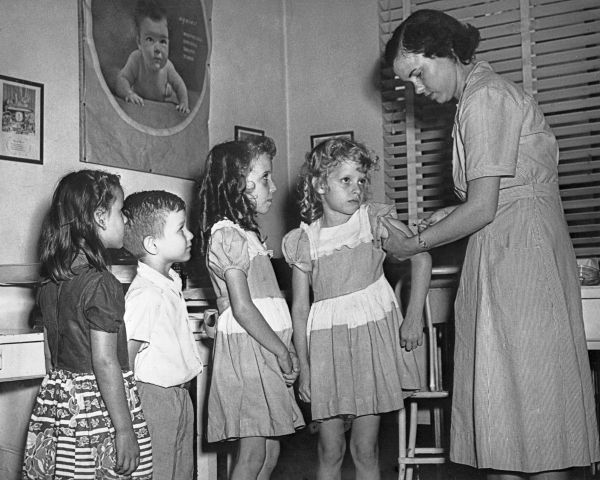By Kathleen Hardee Arsenault
September 1, 2020

In the fall of 1954, I began second grade at Fernandina Elementary School. One day, a little girl named Tamara who sat next to me didn’t come to school. My parents soon learned why. Tamara had been rushed to Jacksonville’s Hope Haven Hospital for Crippled Children, as it was then called, for treatment for paralytic polio.
Tamara’s diagnosis panicked parents and set the Nassau County Health Department to work. The Department had labored since its founding to help keep Amelia Islanders healthy, beginning with oversight of dredging operations to kill yellow fever-transmitting mosquitoes that caused the deadly epidemics of the 1870s. Throughout my school years, they provided our inoculations against childhood diseases (even typhoid fever!) in the school cafeteria. After Tamara’s diagnosis, her classmates were quickly taken by our parents to receive gamma globulin injections. I remember my father turning me over his lap, lifting my dress, pulling down my underpants, and holding me tight while a nurse gave me the extra-large and extra painful injection in my bottom. Gamma globulin, then given to enhance immunity to the virus, seemed to have worked, since we stayed healthy and suffered only a little pain and embarrassment from the experience. Tamara, sadly, never returned to our school.
The following April, oversized headlines and enthusiastic church bells around the country celebrated Dr. Jonas Salk’s announcement that his preliminary trials of a new vaccine were successful. Astonishingly, Doctor Salk refused to patent his vaccine so that it could be offered inexpensively to everyone.
At polio’s peak epidemic, Florida experienced 51 cases per 100,000 people, far less severe than the current COVID-19 outbreak. The Legislature, however, reacted quickly, becoming the first in the nation to fund the new vaccine for all school children, allocating $1,000,000 to inoculate children whose families could not afford medical care. (At that time, the cost of a typical doctor’s injection was $4 to $6!) This funding was later cut to $550,000, since a combination of National Foundation for Infantile Paralysis contributions and federal funding subsidized the vaccine, offering it for free to the state’s first and second graders.
My class, having endured gamma globulin and the sudden death of our teacher, was among the first in the nation to receive the three shots—luckily less painful–partially funded by the coins we conscientiously gave to annual March of Dimes collections. Later in the month, however, inoculations were briefly halted when one version of the vaccine proved defective, but this was soon sorted out and injections resumed. In 1960, we lined up once more to receive the Sabin vaccine, given to us in the more pleasant form of drops on a sugar cube. Long lasting and inexpensive to administer, the Sabin vaccine eventually made polio epidemics a distant memory.
My recollections of polio, however, have a coda: in 1963, at the beginning of my junior year, I was diagnosed with scoliosis and my and my family’s life took an abrupt turn. I then began nine months of treatment at Hope Haven Children’s Hospital where I was admitted in September for a body cast, in November back surgery and recovery, and off and on for periodic cast changes. Finally, on a glorious May day, an orderly cut me free. I thought of Tamara often during these visits when, on my way to the hospital school, orderlies rolled my gurney past the enormous indoor swimming pool where polio patients received physical therapy, but I never saw my classmate again.
All of us who survived the polio years unscathed owe enormous gratitude to the National Foundation’s and March of Dimes’ volunteers and donors, to Dr. Salk and other dedicated scientists for their many decades of research on polio, and to the Florida Legislature and Public Health departments for their support of vaccine distribution. Their impact continues to inspire.
Editor’s Note Kathleen Hardee Arsenault is a native of Fernandina. She currently lives in St. Petersburg, where, until her retirement, she served as dean of the University of South Florida Poynter Library.

Kathy, thank you for sharing your personal experience/knowledge from those mid-fifties polio years. Even though I was in another 2nd grade class at this same school in 1954-55, I don’t recall your classmate’s tragic polio and your class’s painful gamma globulin injections. All I remember are the polio shots given in the cafeteria. Your FBHS classmates rejoiced with you at your “coming out” of the nine-month body cast for scoliosis. Praying for a COVID-19 vaccine that will eventually make it a “distant memory” too.
Dean Arsenault,
thank you for sharing your Polio memories. You will be pleased to learn that Rotary International made a promise to the children of the world to rid our planet of Polio in 1985. Last month Africa completed it third year of no wild poliovirus cases and is now a Polio Free Continent! There remain only two countries, Afghanistan and Pakistan, where Polio still cripples children. Rotary International and its partners, Who Health Organization, Bill and Melinda Gates Foundation and the governments of the world, have their focus on these two countries. We remain committed to our promise made 35 years ago!
The 3 Rotary Clubs of Nassau County are strong advocates and supporters of the Rotary led coalition to eradicate Polio: The Rotary Club of Fernandina, The Rotary Club of Amelia Island Sunrise, and the Greater Nassau County Rotary Club. https://www.endpolio.org/; https://www.rotary.org/en
Tommy Grimes, Past District Governor, District 6970 (Northeast Florida)
This is a story that deserves telling in light of what we, as a nation, are experiencing today. In personalizing the experience, you have made everyone who reads it pause, reflect and realize that this journey called life has many stops along the way that encourage us to make informed decisions. I am left wondering what happened to your classmate…
It has been reported that an outbreak of Polio in the Phillipines was casued by the vaccine. Could that be true?